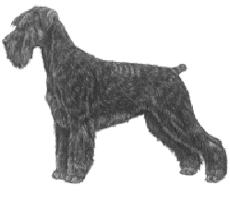Schnauzer (Giant)
General Information - Schnauzer (Giant)

Group:
Utility
Size:
large
Lifespan:
10-12 years
Exercise:
high
Grooming:
medium
Trainability:
medium
Watchdog ability:
very high
Protection ability:
very high
Area of Origin:
Germany
Date of Origin:
Middle Ages
Other Names:
Riesenschnauzer
Original Function:
Cattle herding,
guardian
History
The Giant Schnauzer, also known as Riesenschnauzer, originated in Germany in the 1400's. Its first use was droving cattle. The breed was first exhibited at a show in Munich in 1909. The Giant Schnauzer is a powerful, muscular dog. Its height at the shoulders should match its body length, giving it a square shape when viewed in profile. It has a flat forehead, chin whiskers and a stubby mustache.
Temperament
Confident and bold, Giant Schnauzers are excellent around children, devoted and good-natured. This muscular and spirited breed requires a firm experienced trainer.
Upkeep
The Giant Schnauzer needs daily exercise and fun. Its exercise requirements can be met with vigorous games and long hikes or walks. It can live outside in temperate to cool climates, but it does best when allowed to divide its time between house and yard. Its harsh coat needs combing once or twice weekly, plus shaping two to four times yearly. Shaping is best done by professional scissoring and hand-stripping, but clipping is acceptable for pets.
Schnauzer (giant)
A breed standard is the guideline which describes the ideal characteristics, temperament, and appearance of a breed and ensures that the breed is fit for function with soundness essential. Breeders and judges should at all times be careful to avoid obvious conditions and exaggerations, as well as being mindful of features which could be detrimental in any way to the health, welfare or soundness of this breed.
Breed Standard - Schnauzer (giant)
 General Appearance:
General Appearance: The Schnauzer should be a powerfully built, robust, sinewy, nearly square dog (length of body equal to height at shoulders). His temperament should combine high spirits, reliability, strength, endurance and vigour. Expression keen and attitude alert. Correct conformation is of more importance than colour or other purely “beauty” points.
Head and Skull: Head strong and elongated, gradually narrowing from the ears to the eyes and thence forward toward the tip of the nose. Upper part of the head (occiput to the base of the forehead) moderately broad between the ears -
with flat, creaseless forehead and well muscled, but not too strongly developed cheeks. The powerful muzzle formed by the upper and lower jaws (base of forehead to the tip of the nose) should end in a moderately blunt line, with bristly, stubby moustache and chin whiskers. Ridge of the nose straight and running almost parallel to the extension of the forehead. The nose should be black and full. Lips tight and not overlapping. Medium stop to accentuate eyebrows.
Eyes: Medium sized, dark, oval, set forward, with arched bushy eyebrows.
Ears: Neat and V shaped, set high and dropping forward to temple.
Mouth: Scissor teeth, slightly overlapping from the top; with strongly developed fangs; healthy and pure white.
Neck: Moderately long, nape strong and slightly arched, skin close to throat, neck set cleanly on shoulders.
Forequarters: Shoulders flat and sloping. Forelegs straight viewed from any position. Muscles smooth and lithe rather than prominent; bones strong, straight and carried well down to the feet, elbows set close to the body and pointing directly backward.
Body: Chest moderately broad, deep, with visible strong breast bone reaching down to at least the height of elbow and slightly rising backward to loins. Back strong and straight, slightly higher at the shoulder than at the hindquarters, with short well developed loins. Ribs well sprung. Length of body equal to height from top of withers to ground.
Hindquarters: Thighs slanting and flat, but strongly muscled. Hindlegs (upper and lower thighs) at first vertical to the stifle, from stifle to hock in line with the extension of the upper neck line, from hock vertical to ground.
Feet: Short, round, extremely compact with close:arched toes (cat’s paws) dark nails and hard soles. The feet also deep or thickly padded, pointing forward.
Tail: Set on and carried high, customarily docked to three joints.
Coat: Hard and wiry and just short enough for smartness, clean on neck, shoulder, ears and skull, plenty of good hard hair on front legs. Good undercoat is essential.
Colour: All pepper and salt colours in even proportions, or pure black.
Height: The ideal height for bitches shall be between 60 cms and 65 cms (23.5 inches and 25.5 inches) and for dogs between 65 cms and 70 cms (25.5 inches and 27.5 inches). Any variation of more than 3 cms (1 inch) in these heights should be penalised.
Faults: Too heavy or too light; too low or high on the leg. Head too heavy or round; creased forehead; sticking out or badly carried ears; light eye, with yellow or light grey rings; strongly protruding cheek-bones; flabby throatskin; undershot or overshot jaw. Muzzle too pointed or too small. Back too long, sunken or roached; barrel shaped ribs; slanting crupper; elbows turned out; heels turned in; hindpart overbuilt (too steep). Toes spread open; paws long and flat (hare). Coat too short and sleek, or too long, soft or curled. All white, spotty, tigered or red colours. Small white breast spot or marking is not a fault. Among other serious faults are cow:hocks, sunken pasterns, or any weakness of joint, bone or muscular development.
Note: Male animals should have two apparently normal testicles fully descended into the scrotum.
DNZ No 690
Copyright Dogs New Zealand
19 Dec 2013
Any departure from the foregoing points should be considered a fault and the seriousness with which the fault should be regarded should be in exact proportion to its degree and its effect upon the health and welfare of the dog and on the dog’s ability to perform its traditional work.




